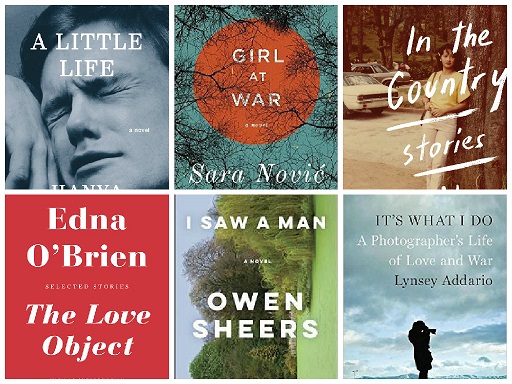We came, we read, we gushed.

The Containment: Detroit, the Supreme Court, and the Battle for Racial Justice in the North by Michelle Adams (Farrar, Straus and Giroux). Reviewed by William Rice. “Reasoned argument promising broadscale government remediation of public ills seems so alien to our current political moment as to be almost incomprehensible. Yet that’s what The Containment: Detroit, the Supreme Court, and the Battle for Racial Justice in the North actually offers us. Author Michelle Adams’ meticulous account of the 1970s school-desegregation case that almost ended — but didn’t — educational apartheid in Michigan’s largest metropolis and potentially across the entire North feels nostalgic in its focus on real problems, concern for justice, and reliance on facts. But believe it or not, kids, that’s what politics and policy used to be about!”
Raised by a Serial Killer: Discovering the Truth About My Father by April Balascio (Gallery Books). Reviewed by Diane Kiesel. “Balascio graduated from high school and escaped her father’s house. In her place came a foster son, Dannie Boy, who legally changed his surname to Edwards. He joined the military and took out $250,000 in life insurance, naming his new foster father as the beneficiary. Injured in basic training, Dannie Boy was about to get a medical discharge in May 1996 when he mysteriously went AWOL. His decaying body — with a gunshot wound to its head — was found in a shallow grave near Edwards’ house a year later. His now-grown children whispered among themselves: Could the killer be dear old Dad?”
Alternative Facts: Stories by Emily Greenberg (Kallisto Gaia Press). Reviewed by Matt Fleck. “Greenberg also demonstrates surprising range in voice, point of view, and form, making Alternative Facts a compelling read. Perhaps most notable is that she has managed to craft fiction about current events — and, consequently, about politics — with compassion but without exoneration or preaching. As conversations about the purpose of art grow louder, she shows that art can address the elephant in the room without prescribing opinions about it.”
Jesus Wept: Seven Popes and the Battle for the Soul of the Catholic Church by Philip Shenon (Knopf). Reviewed by Teddy Duncan Jr. “While Shenon’s book is exemplary at detecting and documenting those points of hypocrisy…it doesn’t always explore the underlying reasons some in the Church may oppose certain changes…Despite this occasional lapse, Jesus Wept provides an impressive overview of the Catholic Church told in a neat, nuanced narrative that captures its triumphs — its charity and teachings of transcendent love — along with its abysmal failures: its censorship of dissent, inability to contend with modernity, and deliberate concealment and propagation of priestly abuse.”
Black in Blues: How a Color Tells the Story of My People by Imani Perry (Ecco). Reviewed by Sarah Trembath. “Black history books, for example, often chronicle human-rights abuses and commemorate resilient and courageous leaders of the masses who are in search of true freedom from those abuses. This is important work. But every so often, a work in that genre reveals itself to be refreshingly free from the binary of oppression and liberation. Imani Perry’s Black in Blues: How a Color Tells the Story of My People is one: a welcomed exploration of Black artistry, Black surviving, Black thriving, Black spirituality, and Black intellect through Black folks’ long-established connection to the color blue.”
Fagin the Thief: A Novel by Allison Epstein (Doubleday). Reviewed by John P. Loonam. “Fagin is first humanized by being given a name — Jacob — and he is referred to most often by that name, never by his religion. His mother, Leah, is a hardworking seamstress trying to provide for her son in a small Jewish enclave in 1790s London. Leah dotes on Jacob and encourages him to read and to study with the local rabbi. Jacob’s father is absent, having been hanged as a thief, a legacy that taints Jacob. When a nosy and pious neighbor warns Leah that ‘the path to the gallows is in this one’s blood,’ it reads as prejudice. But it turns out she’s right.”
When Charlie Met Joan: The Tragedy of the Chaplin Trials and the Failings of American Law by Diane Kiesel (University of Michigan Press). Reviewed by Ken Ackerman. “The story is tawdry. Back in the early 1940s, as our boys were off fighting World War II, Chaplin had a fling with a wannabe actress, a 21-year-old ingenue calling herself Joan Barry. At the time, Chaplin was in his prime: a Hollywood magnate, co-owner of United Artists and running his own studio, wealthy, with mansions and lawyers aplenty. At 52, he was promiscuous and flirty, especially with much younger women. He and Barry fell in lust. Chaplin signed her to a film contract and promised to make her a star. She was thrilled. But then it all went bust.”
Subscribe to our newsletter here, and follow us on Instagram, Bluesky, Facebook, Pinterest, and LinkedIn. Advertise with us here.

